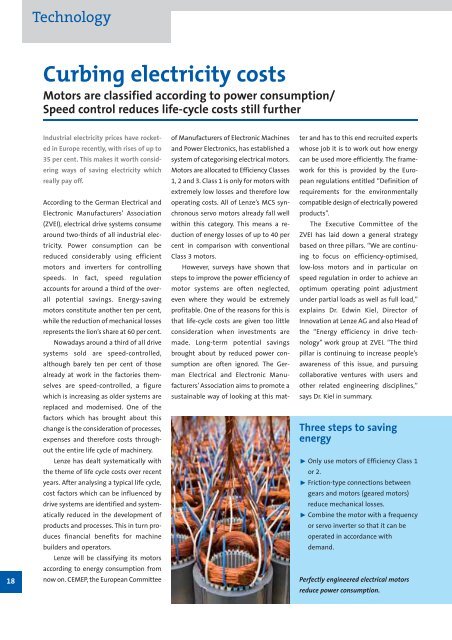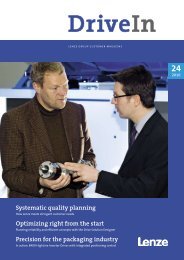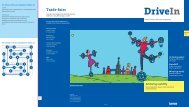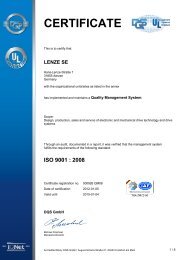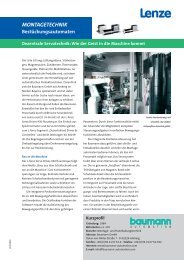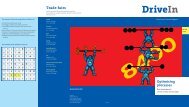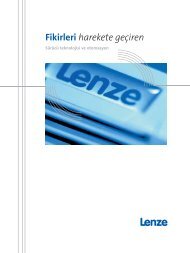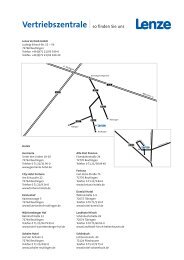Trade fairs - Lenze
Trade fairs - Lenze
Trade fairs - Lenze
Create successful ePaper yourself
Turn your PDF publications into a flip-book with our unique Google optimized e-Paper software.
18<br />
Technology<br />
Curbing electricity costs<br />
Motors are classified according to power consumption/<br />
Speed control reduces life-cycle costs still further<br />
Industrial electricity prices have rocketed<br />
in Europe recently, with rises of up to<br />
35 per cent. This makes it worth considering<br />
ways of saving electricity which<br />
really pay off.<br />
According to the German Electrical and<br />
Electronic Manufacturers’ Association<br />
(ZVEI), electrical drive systems consume<br />
around two-thirds of all industrial electricity.<br />
Power consumption can be<br />
reduced considerably using efficient<br />
motors and inverters for controlling<br />
speeds. In fact, speed regulation<br />
accounts for around a third of the overall<br />
potential savings. Energy-saving<br />
motors constitute another ten per cent,<br />
while the reduction of mechanical losses<br />
represents the lion’s share at 60 per cent.<br />
Nowadays around a third of all drive<br />
systems sold are speed-controlled,<br />
although barely ten per cent of those<br />
already at work in the factories themselves<br />
are speed-controlled, a figure<br />
which is increasing as older systems are<br />
replaced and modernised. One of the<br />
factors which has brought about this<br />
change is the consideration of processes,<br />
expenses and therefore costs throughout<br />
the entire life cycle of machinery.<br />
<strong>Lenze</strong> has dealt systematically with<br />
the theme of life cycle costs over recent<br />
years. After analysing a typical life cycle,<br />
cost factors which can be influenced by<br />
drive systems are identified and systematically<br />
reduced in the development of<br />
products and processes. This in turn produces<br />
financial benefits for machine<br />
builders and operators.<br />
<strong>Lenze</strong> will be classifying its motors<br />
according to energy consumption from<br />
now on. CEMEP, the European Committee<br />
of Manufacturers of Electronic Machines<br />
and Power Electronics, has established a<br />
system of categorising electrical motors.<br />
Motors are allocated to Efficiency Classes<br />
1, 2 and 3. Class 1 is only for motors with<br />
extremely low losses and therefore low<br />
operating costs. All of <strong>Lenze</strong>’s MCS synchronous<br />
servo motors already fall well<br />
within this category. This means a reduction<br />
of energy losses of up to 40 per<br />
cent in comparison with conventional<br />
Class 3 motors.<br />
However, surveys have shown that<br />
steps to improve the power efficiency of<br />
motor systems are often neglected,<br />
even where they would be extremely<br />
profitable. One of the reasons for this is<br />
that life-cycle costs are given too little<br />
consideration when investments are<br />
made. Long-term potential savings<br />
brought about by reduced power consumption<br />
are often ignored. The German<br />
Electrical and Electronic Manufacturers’<br />
Association aims to promote a<br />
sustainable way of looking at this mat-<br />
ter and has to this end recruited experts<br />
whose job it is to work out how energy<br />
can be used more efficiently. The framework<br />
for this is provided by the European<br />
regulations entitled “Definition of<br />
requirements for the environmentally<br />
compatible design of electrically powered<br />
products”.<br />
The Executive Committee of the<br />
ZVEI has laid down a general strategy<br />
based on three pillars. “We are continuing<br />
to focus on efficiency-optimised,<br />
low-loss motors and in particular on<br />
speed regulation in order to achieve an<br />
optimum operating point adjustment<br />
under partial loads as well as full load,”<br />
explains Dr. Edwin Kiel, Director of<br />
Innovation at <strong>Lenze</strong> AG and also Head of<br />
the “Energy efficiency in drive technology”<br />
work group at ZVEI. “The third<br />
pillar is continuing to increase people’s<br />
awareness of this issue, and pursuing<br />
collaborative ventures with users and<br />
other related engineering disciplines,”<br />
says Dr. Kiel in summary.<br />
Three steps to saving<br />
energy<br />
˘ Only use motors of Efficiency Class 1<br />
or 2.<br />
˘ Friction-type connections between<br />
gears and motors (geared motors)<br />
reduce mechanical losses.<br />
˘ Combine the motor with a frequency<br />
or servo inverter so that it can be<br />
operated in accordance with<br />
demand.<br />
Perfectly engineered electrical motors<br />
reduce power consumption.


